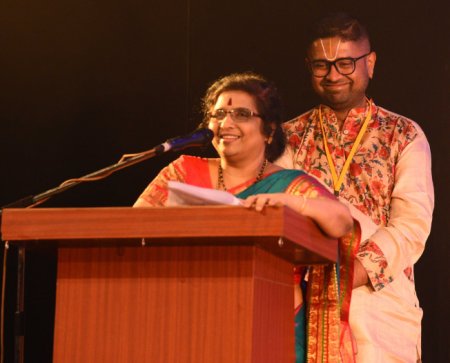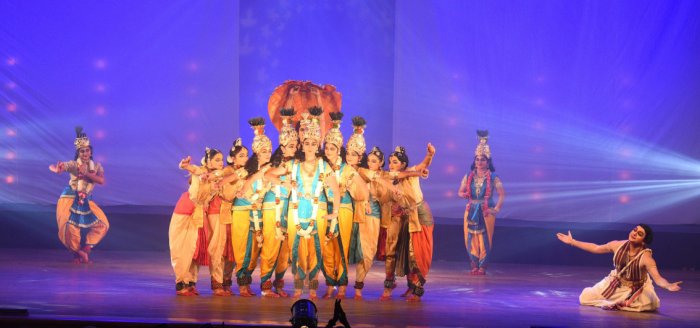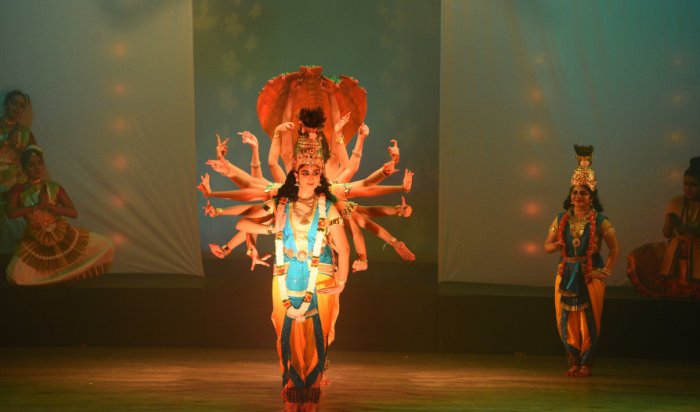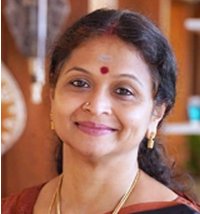
|   |

|   |
Agre Pashyami - Dr. Padmaja Suresh e-mail: padmajasuresh@hotmail.com Photos: Gnanachandra February 25, 2023 AGRE PASHYAMI world premiere in Bangalore on the 18th of February at Chowdiah Memorial Hall, organized by Desika Daya Trust was an unforgettable and thrilling experience for all the Rasikas. The production explores the varied aesthetics of the Drishya Kavya 'Narayaneeyam' and testifies to the exemplary material available to compose and choreograph it. Guruvayur in Kerala is consecrated to Sri Krishna. The abundant glory of the temple rests on the divine power of the deity to cure ailments and bless devotees with sound health and prosperity. The origin of this sacred shrine has a hoary antiquity. Narada Purana alludes to Janamejaya, the son of Parikshit, who was attacked by a virulent type of disease for the sin of killing innocent serpents in the great sacrifice that he performed to avenge the death of his father. Sage Atreya once suggested (as a means to cure), the propitiation of Sri Krishna at Guruvayur. The Sage then revealed to the King that this is the image of Padmanabha, entrusted with Brahma by the Supreme during the previous deluge and given to Prajapati Sutapas to whom in three successive births, the lord was born. In the third life as Vasudeva, he became his son Krishna. On the eve of the destruction of Yadukula and the submergence of Dwaraka, Krishna asked Udhava to go to Brihaspati/Guru, to protect the image. Guru met Vayu who in turn, carried the image. Both were instructed by Lord Shiva to arrive at a divine place, thereafter to be known as 'Guruvayupura' to install the same. The author of this work, Narayana Bhattathiripad hails from Melpattur in South Malabar, roughly in the 16th century. An erudite scholar and poet, Achyuta Pisharoti, had once goaded him to lead a life of prayer and religious duty. Bhattathiri who was a versatile genius required a preceptor. He gained mastery over Sanskrit, guided by Pisharoti. His devotional love to Narayana, hitherto dormant, soon blossomed with literary works from Ramayana, Mahabharata and the Puranas. They contained poetic excellence and the sublime ideas suffused with Bhakti, were replete with melodious diction.  Anitha Guha and Dushyant Sridhar An incident when Pisharoti was attacked with rheumatism is well-known. The disciple Bhattadiri took upon himself, this disease. Afflicted with malady, he fervently appealed to Guruvayurappan by reciting one Dasaka a day, until he became cured at the last. Narayaneeyam comprehends the lofty ideas in Srimad Bhagavatam and is an exquisite poem that proclaims devotion as the only panacea for human misery. The goal of life is attained through Karma (action), Jnana (knowledge) and Bhakti (devotion). The last is the easiest means to achieve both the Purusharthas and Mukti. A true devotee sees the Supreme in the individual soul. It is this gospel that the author-poet maintains in his masterpiece, instilling into the minds of the reader, an elevated and enlarged vision that ennobles our thoughts and deeds. No wonder such a gargantuan masterpiece commands the influence of a Veda in Kerala. 'Agre Pashyami' which has been brought forth by the team of Dushyant Sridhar, Anitha Guha, Rajkumar Bharati and others, has amplified its relevance to present times when mankind gets often steeped into infirmities due to new diseases and the like. The Dasaka 1 is the description of the greatness of the Lord. In the very first chapter, the poet wishes that Bhakti alone, should arise in him soon, which is the softening of the ecstasy of intense love. The description of the nature of Bhakta and prayer for Bhakti is given in subsequent chapters before going on to the Gunas and Leelas of the Lord. Maya has no place where the torrent of Bliss Absolute flows from the abode of the Lord - Vaikuntha. Highlighting this philosophy, the dance-drama opened up with a cherubic Kocchu Guruvayurappan, donning a Mayil-Peeli tuft, glowing like a blue sapphire, illuminated by gems and holding butter in his little palm, as seen by the poet. The scene portraying the lustrous Keralam with Krishnanattam Kali was followed by dancers dressed as well-ornamented elephants in the temple procession. The narratives by Dushyant Sridhar who has conceptualized the production, gave an elaborate description for every piece and kept everyone engrossed. All the eleven aspects of Natya as a Sangraha, namely Rasa, Bhava, Abhinaya, Dharmi, Vrtti, Pravrtti, Siddhi, Swara, Atodya, Gana and Ranga were established before the full house, as a fitting tribute to Bhattathiripad. The ambience was filled with emotions that poured out, proving the power and influence of Natya, that can drive devoted hearts towards the higher beatitude. It was as if at once, one could acquire Salokya- Living in the world of the Lord, Sameepya- Living close by to the Lord, Sarupya- In the same form as the Lord and Sayujya- Absorption with the Lord, within a short span of two hours. All the required attributes could be achieved by immersing oneself in Rasa.  The music score by Rajkumar Bharati was a riveting account of what the scriptures say - One moment in Ragabhava and Laya is equal to a thousand rituals. The dance was 'deeply heard' and the music 'truly seen'. Costumes and make-up were designed to enhance the appeal and create a marvellous spectacle. Karuna bhava was gently evoked with a humble Poontanam's Jnanapaana being haughtily ignored by Bhattathiri, followed by a moving 'Karuna Cheyvan' in Yadukulakambhoji, for a paralyzed Bhattathiri. The scene while Lakshmi appeared, like a streak of lightning, a creeper like delicate form, infatuating the onlookers and illuminating the quarters, the singer suddenly broke into the familiar tune of Purandara's Ragamalige 'Ksheerabdhi Kannike' wherein, the bride Lakshmi has to decide whom to wed. It was a novel transition from Balakrishnan to Lakshmi-Pati with Srngara Rasabhava that caught one's attention. The Varaha Avatara stood out with some compelling acrobatic martial art in the dance, the drama getting accentuated with the Sudarshana Cakra wielded finally, to crush Hiranyaksha. Kalinga Nartanam adopted the Oothukadu Venkata Kavi's irresistible Tillana in Gambheera Nattai to project Krishna in a playfully sportive yet dexterously vigilant dance, atop the serpent that he subjugates. The tinkling bells won our hearts instantly. The program, keeping Narayaneeyam as the focus, did blend other literary sources with the theme. Narasimha Avatara episode from Narayaneeyam, added on the 'Narasimha-ashtakam' of Vijayendra Teerthar. In fact, compositions that extol Guruvayurappan, by Lalita Dasa and Ambujam Krishna embellished the presentation which included hymns of Andal, Vedanta Desika, Taittiriya Samhita, verses from an Abhang, Ashtapadi and Silappadikaram as well. Bhattathiri had in one sloka from the chapters on Ramavatara, most beautifully and briefly described the Sundarakandam which was depicted well. Rasakreeda in the text had been earmarked five chapters by the poet. The instinct of love in an individual when directed towards the Supreme, undergoes a transformation into the sublime spirit, called Prema Bhakti. Every sentiment attains its culmination through this transcendence. The Rasa development in this dance, through the Vibhava, Anubhava, Sattvika and Vyabhicari gained momentum in a spiral trajectory, progressively bringing us to an astral realm with Krishna as the centripetal force. The life of Sri Krishna may be divided into four main periods, viz. Vrindavan, in his youth as a hero at Mathura, later as a king of Dwaraka and lastly as a spiritual guide in the Mahabharata. His life at Vrindavan is more divine and mysterious than human reason could comprehend. Before his advent into the world, he casts a magic spell on the sentinels. As a baby, he reveals his divine form to mother Yashoda and arrests the tricks of Poothana. More so are his adventures as he grows up. The destruction of many like the demon Sakata and others, the master trick played by Brahma by assuming the forms of the various calves concealed, the lifting up of the mount Govardhan, the forest conflagration, and to crown them all, is his dalliance with the Gopis, which has tremendous metaphysical significance. The Lord himself says, as mentioned in Brihat Vamana Purana that Gopis should attain their goal, only through their unalloyed love towards him. The Gopis are but the 'Hladini Shakti' of the Lord that is joy-rendering. Uddhava compares his devotion towards Krishna with that of the Gopis. Uddhava says that he may be some creeper or plant in Vraja in contact with the holy feet of the Gopis. Hence it is said that the recitation of Rasaleela is so efficacious as to destroy one's sins, conducing to auspiciousness.  There was rapture in the auditorium as Krishna assumed as many forms as the Gopis to dance with them all. In the above scenes, Nrtta Karanas from Mohiniattam and Kathakali besides Bharatanatyam were suitably employed by the choreographer, also adding a semblance of the poet's region. To mention other chapters from the text that were not depicted in this performance, is perhaps to lead the way for possibilities of a sequel to a grand production. Narayaneeyam's Dasaka 43rd - Trinavartavadhanam is important, from the view of curing one's arthritis disease, caused by excessive Vata/wind, symbolized by a demon Trinavarta. Similarly, there are not that very well-known episodes in Dasaka 74th that can be explored, like that of Kubja - the hunch backed woman and the breaking of the bow, the destruction of a washerman, the blessing of the tailor and the garland maker. Dasakas on Rugmini Swayamvaram, Kuchelopakhyanam are indeed very interesting and with great scope for drama. Looking at the constraints of time, the production has culled out some chosen ones, that do give a holistic approach to the subject. Now as to the central figure in the work, it is the attractive all-lovely form of Krishna, the full incarnation of the Lord Supreme. Agre Pashyami concludes with the title of the dance-drama which is the 100th Dasaka- description of the Lord from head to foot. Here in this last Dasaka the author describes in bliss and fervour, 'that divine vision' of Krishna, as was finally revealed to him. The Vishwarupam image was very well carved out by all dancers in the sequence. The core dance team comprised of Yatin Agarwal, Nidheesh, Pavitra Bhat, Satvika Shankar, Smriti Vishwanath, Anjali Hariharan, Smriti Sudhakar, Ravali Mylavarapu, Varsha Rajkumar, Sandhya Shankar, Nutana Nair, Sanjana Narayan, Sneha Vasan, Madhumita Raghuraman, Shreya Srikant and Radha. Kudos to each and every one of them!  Dr.Padmaja Suresh is an acclaimed Bharatanatyam dancer and research scholar and heads the Aatmalaya academy, Bangalore. |